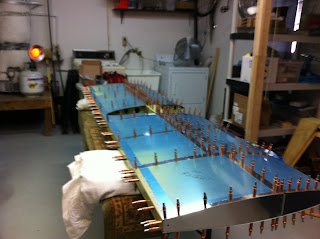Page 10-04 Build Time: 228 hrs
This weekend I managed to get the tail cone skins through primer. It was every bit the PIA I expected it to be. Getting seven foot skins in a five foot booth was a lot of work in flipping wet skins, turning them around, trying to handle them without touching the paint and hanging them up to dry. I must say, if I didn't live near the coast I would not prime. But I do and after an eight hour day in a respirator, a couple beers and a nap the skins look awesome.
I've been weighing each part pre / post primer to try to assess the overall gain but these were too big to put on the scale. Also there's quite a bit of overspray on the plastic that will come off and not count in total weight. Total paint used in this session was 24 oz. This is the most I've used so far. I mix 8 oz at a time and clean the gun after 8 oz. It takes a couple hours to get through one cycle.
With the parts dry enough to work with the next day I couldn't resist some assembly. I had planned on flying but thunder storms were predidted and there's no way I'm going out in that. As it turned out there was a area warning for hail which is rare here in CA. Better to be on the ground wishing you were flying as they say.
I was pretty surprised by how much the sides of the bottom had to be pulled in with clecos. I checked and double checked but they were the right parts in the right direction so I let the clecos do the work. You really want to work this slowly and not stress any one section. Once Aluminum stretches it's pretty hard to shrink it back but it all came out very nice. I also noticed that placing the saw horses where the plans tell you to loaded the center section of the skin. This caused some small allignment issues but once I move the saw horse behind the forward frame everything relaxed and the fit was fine.
I'm watching this area closely since a couple of 12's have had wrinkling in this section. One of them was at Vans when I picked up my kits. I'm hoping it's just assembly loading and I can avoid it by keeping the skins well supported without any stress.
 |
| Bottom tail cone coming together |
While setting up for scuff I loosely assembled the skins so I could mask off the areas beyond the overlap. In one section I noticed the holes weren't lining up. The error is only 1/32 but it sets about a dozen holes off by that much. I have it flagged and will contact Vans if it's still a problem during final assembly.
Glad to see some big parts coming together... Finally.

















































